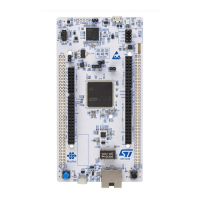UM2407 Rev 1 17/48
UM2407 Hardware layout and configuration
47
6.3 Embedded STLINK-V3
There are two different ways to program or debug the on-board STM32H7 MCU:
• Using the embedded STLINK-V3
• Using an external debug tool connected to CN5 MIPI-10 connector.
The STLINK-V3 programming and debugging tool is integrated in the STM32H7
Nucleo-144 board.
The STLINK-V3 makes the STM32H7 Nucleo-144 board Mbed enabled.
The embedded STLINK-V3 supports only SWD and VCP for STM32H7 devices. For
information about debugging and programming features refer to Overview of ST-LINK
derivatives, Technical note (TN1235), which describes in details all the STLINK/V3 features.
Features supported on STLINK-V3STLINK-V3:
• 5 V power supplied by USB connector (CN1)
• USB 2.0 high-speed-compatible interface
• JTAG/serial wire debugging (SWD) specific features:
– 3 V to 3.6 V application voltage on the JTAG/SWD interface and 5V tolerant inputs
–JTAG
– SWD and serial viewer (SWV) communication
• Direct firmware update feature (DFU) (CN2)
• STDC14 (MIPI10) compatible connector (CN5)
• Status COM LED (LD4) which blinks during communication with the PC
• Fault red LED (LD6) alerting on USB overcurrent request
• 5 V/300 mA output power supply capability (U2) with current limitation and LED
• Green LED ON: 5V enabled (LD5)
6.3.1 Drivers
Before connecting the Nucleo-144 board to a Windows 7, Windows 8 or Windows XP PC
via USB, a driver for STLINK-V3 must be installed (not require for Windows 10). The driver
is automatically installed by the toolset supporting ST-LINK. It is also available from the
www.st.com website.
In case the STM32H7 Nucleo-144 board is connected to the PC before installing the driver,
the PC device manager may report some Nucleo interfaces as “Unknown”.
To recover from this situation, after installing the dedicated driver, the association of
“Unknown” USB devices found on the STM32H7 Nucleo-144 board to this dedicated driver,
must be updated in the device manager manually.
Note: It is recommended to proceed using USB composite device, as shown in Figure 8.

